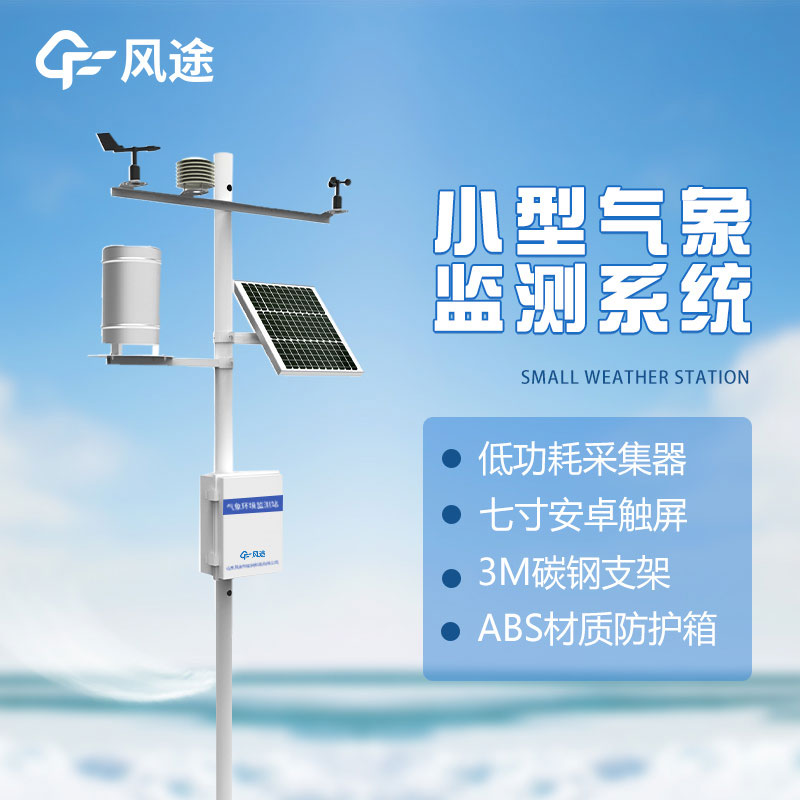Shandong Fengtu IOT Technology Co., Ltd
Sales Manager:Ms. Emily Wang
Cel,Whatsapp,Wechat:+86 15898932201
Email:info@fengtutec.com
Add:No. 155 Optoelectronic Industry Accelerator, Gaoxin District, Weifang, Shandong, China

Sales Manager:Ms. Emily Wang
Cel,Whatsapp,Wechat:+86 15898932201
Email:info@fengtutec.com
Add:No. 155 Optoelectronic Industry Accelerator, Gaoxin District, Weifang, Shandong, China
time:2023-07-13 17:24:22 source:Weather Station viewed:490 time
A five-element weather station is a weather station that can measure five basic meteorological elements: temperature, humidity, barometric pressure, wind speed and wind direction. These elements are basic observations commonly used in meteorology and are important indicators of weather, climate and atmospheric conditions. A five-element weather station typically includes the following hardware:
Temperature and humidity sensors: used to measure atmospheric temperature and humidity.
Barometric pressure sensor: Used to measure atmospheric pressure.
Wind speed sensor: Used to measure wind speed.
Wind direction sensor: Used to measure the direction of the wind.
Sunshine Sensor: Used to measure the duration and intensity of sunshine.
The five elements weather station is the most basic, most commonly used and most common meteorological measurement equipment in meteorology, which is widely used in the fields of agriculture, water conservancy, transport, environmental protection, as well as weather forecasting, climate research and other aspects. With the progress of technology and the continuous increase of meteorological demands, the functions and accuracy of five-element weather station are also gradually improved, such as increasing the functions of data storage, transmission, processing, etc., improving the automation degree and accuracy of the instrument, with higher working efficiency and higher data accuracy.
The five-element weather station plays a wide range of roles, mainly including the following aspects:
Weather forecasting: five-element weather station monitors the changes of meteorological elements, which can provide basic meteorological data to help the meteorological department to make weather forecasts and protect the public's life and property safety.
Water conservancy and irrigation: five-element weather stations measure the changes of meteorological elements, which are very useful for water conservancy and irrigation. By monitoring and analysing rainfall, hydrological and meteorological data, it is possible to accurately predict water supply, manage water resources, plan water conservancy projects and improve water efficiency.
Agricultural production: Five-element weather stations measure changes in meteorological elements, which can help agricultural producers better understand and predict changes in meteorological conditions and the growth of crops. Refined and precise meteorological forecasts can help agricultural producers manage their crops more accurately in terms of fertiliser application, irrigation, disease prevention, etc., and improve the ability of crops to produce stable yields and maintain harvests.
Energy development and utilisation: The five-element meteorological station monitors meteorological data such as solar radiation, wind speed, air temperature and humidity, which can help developers in the energy sector to select and plan suitable renewable energy power generation facilities such as wind power and solar power, and improve the efficiency of energy development and utilisation.
Environmental protection: the five-element weather station can monitor air quality, air pollutants and meteorological conditions and other data, providing an important basis for environmental pollution early warning, environmental monitoring and promoting the construction of ecological civilisation.
In short, the five-element weather station monitors the changes of meteorological elements, provides basic meteorological information for all walks of life, and helps people better adapt to climate change and the natural environment, and improves production efficiency and quality of life.

Seven-in-one weather sensor FT-WQX7 is a sensor launched by Fengtu Technology, based on the ultrasonic principle of manufacturing, integrating seven observation elements - temperature, humidity, wind speed, wind direction, atmospheric pressure, rainfall, light, one-piece simple design, wear-resistan...
In today's agricultural production, moisture monitoring system is playing an increasingly important role. Like a guardian, it keeps an eye on the condition of the soil and provides farmers with timely and accurate information to help them rationally utilize water resources and improve the yield...
Fengtu, as a manufacturer of Online Ammonia Nitrogen analyzers, has launched two ammonia nitrogen detectors, both of which are common instruments in the market.Firstly, the FT-ZS5 Online Water Quality AnalyzerIt integrates a water quality ammonia nitrogen sensor, a measurement module, an...
best professional weather station provides indoor and outdoor temperature and humidity, wind speed and direction, air pressure and rainfall....